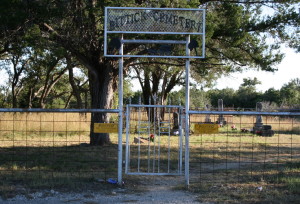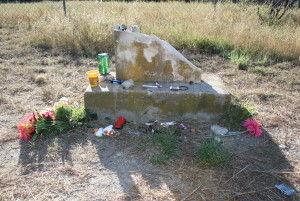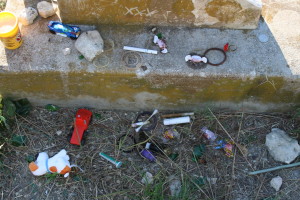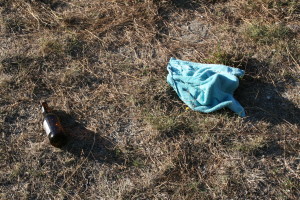I’d known about the legend of the infamous Liberty Hill witch grave for a while but only recently managed to drive up there and have a look around. It seemed a perfect thing to document for Halloween, because the legend, though unlikely, is fueled by witchcraft, cruel death and creepy graveyard stories, and though a creation of the digital age, seemed to have some interesting historical relevance. But this was one of those times when the damage done by the legend far outweighs the value of recently-created folklore.
The Liberty Hill witch grave is an example of new folklore, and is largely a creation of Internet sites that breathlessly repeat rumors as fact and take EVP tapes gathered by ghost hunters as solid evidence. My research shows that the stories of the witch grave really started to get traction in the last 20 years or so, and have been spread through ghost hunters who visit the cemetery at night to talk to the dead witch and assorted “weird” sites that tell ghost stories. Older locals in Andice and Liberty Hill, small towns north of Austin in the Texas Hill Country, especially those who don’t spend hours online each day, haven’t heard of the witch grave or only know about it now because they are appalled by the amount of destruction ghost hunters and drunk teenagers have done to the cemetery.
Often legends need to stand as they are – critical analysis of the legends seldom does any good because people who have a will to believe will not be dissuaded by facts and because most of the time truth in such stories doesn’t matter. For example, I’ve shared my trip to Baby Head, Texas on this site – Baby Head gets its name because there are stories of a Comanche raid that resulted in the beheading of a little settler girl. I don’t know if that happened, but have come to believe that because the first grave in the Baby Head Cemetery is that of a little girl who died on New Year’s Day, and because Baby Hill/Llano was once in the middle of Comanche territory, the town name may not be based in whole truth but is certainly derived from genuine trauma or terror. Real Comanche incursions into pioneer settlements combined with that tiny dead girl fueled the legend of the little girl who lost her head to the Comanches, the girl behind the legend that gave Baby Head its name. People who lived during the dangerous time described in the legend actually created the legend, so even if it is not wholly accurate the story was fueled by genuine experience.
Such legends are organic outgrowths of genuine events and even if they are not true in the factual sense, they are true in that they represent the collective fears and anxiety of a particular group of people in a particular place and time. The Liberty Hill witch grave is not one of those kinds of legends. It’s cobbled together using elements borrowed from other places and times, it’s not a story that attempts to explain some unpleasant reality of frontier life because tensions regarding slavery were long in the past when the myth was created (though certainly elements of the story may have some factual basis in social injustices that happened to other black women in Texas). It’s a bad ghost story that doesn’t really add to the lore of Texas or depict social issues of the past so much as it contributes to wholesale vandalism of historical sites.
(9/14/17: I received an interesting email from a reader who didn’t want to leave a comment and prefers to remain anonymous, but the questions she raised are worth discussing so I am going to address her concerns in the sections appropriate. She was alarmed by what she perceived as a statement I made that in modern Texas there are no racial divisions and racist actions perpetrated by citizens and authority figures. As a life-long Texan I certainly know there are problems with racism in my home state. The point I was trying to make is that the Liberty Hill witch legend is not a legend that attempts to portray or explain the travails of female slaves. Instead it’s a modern mishmash of assorted legends that don’t represent the experiences or customs of any person alive when slavery was still legal in Texas.
I am unwilling to cede the leeway given in other inaccurate but culturally important legends to the tale of “Elizebeth Simpson.” The Liberty Hill witch grave story was created at least 130 years after the Civil War. The people who created the legend were probably at least four generations removed from anyone who was held in bondage in Texas or owned slaves. The person who created the witch legend did not directly experience slavery in Texas. The racial climate when this story was created was not perfect but it was significantly different than it was in the 1860s. The world is and always will be racist to varying degrees but it, for me, a bridge too far to think that whoever created the Liberty Hill witch legend did so with the intent of representing racial tensions he or she never experienced in a time long past. That makes this legend all the more offensive because it becomes a placeholder, and a particularly bad one at that, for the stories of actual black women who were subject to extrajudicial punishments and lynchings.)
So let me tell you about the story of the Liberty Hill witch grave, show you some pictures, and then explain, using common sense, why the story is nonsense, and using factual record to show why it’s absolutely false. I’m going to leave the analysis of the myth under the cut so that way people who just want to revel in the ghost story can skip my commentary. Also, I have set up an album in Flickr that shows the whole of the cemetery so those who love cemetery porn can see some old Texas graves, some of genuine historical worth.
Click on any picture in this entry to see a larger version.

The Liberty Hill witch grave, located in the Bittick family cemetery in Williamson County, is said to contain the mortal remains of a slave named “Elizebeth Simpson.” The legend says that in 1862, “Elizebeth Simpson,” a slave woman, was hanged to death for stealing one of her master’s horses. She was dragged to the Bittick family cemetery, hanged from one of the oak trees in the center of the parcel of land, then cut down and buried there. Other legends indicate Elizebeth was hanged for witchcraft but witches in the Hill Country were thin on the ground. I can’t find a single historical record to indicate anyone was ever executed for witchcraft in Texas. Frankly the horse story makes a lot more sense – stealing livestock is serious business even now, but common thieves seldom make curses from the grave the way hanged witches do.

Her stone said she was born on April 10, 1834 and died on September 24, 1862. Her head stone had the following saying:
And remember as yo ar pasin by yo must die as well as I
That inscription has been interpreted by some to be a dark curse of sorts, with people insisting it means that anyone who walks in front of “Elizebeth’s” grave will be hanged unless they leave her some sort of offering to appease her. And I use past tense describing the stone because it’s been destroyed – I am relying on an older picture of the stone I’ve found online to show its original form. A picture taken by someone else before it was wholly obliterated is under the cut.

Ghost hunters have come to “Elizebeth’s” stone and recorded all kinds of EVPs they claim demonstrate moans they claim no one heard while they were recording, as well as ghostly whispers.
To keep from being hexed by the curse on the stone, or possibly in attempts to curry favor with the dead slave, people leave gifts and offerings on the grave, like toys, alcohol and coins. Curiously, other stones throughout the cemetery are covered in coins, mostly pennies and quarters. I worry that because “Elizebeth’s” stone has been destroyed and lacks visual impact that ghost seekers are going to other graves. One grave of a dead child who was born the day before Halloween 150 years ago was festooned with quarters, and a rock tomb belonging to a child was also covered with change.


Some try to raise her spirit to speak to them via seances and ouija boards. Mr OTC found this handmade ouija board folded up in some tall grass in the northwest corner of the cemetery.

Far creepier than leaving beer bottles on the gravestone of a possibly executed slave woman is that it appears that people engage in carnal activities on or near “Elizebeth’s” grave.


I would like to beg everyone who thinks of going into this cemetery to commune with a dead woman to please not have sex on her grave. From the standpoint of courtesy, having sex on a grave is impolite. But I suspect the sorts of folk who fornicate in cemeteries are not often bothered by social niceties. If you are the sort who doesn’t care about graveyard etiquette, bear in mind I got poison oak just walking through the cemetery – the sap seeped through my jeans. And let us not speak of all the broken glass from shattered beer bottles around “Elizebeth’s” stone. If you anger the dead by engaging in any sort of activity that may require even partial nudity, you may find the dead achieve vengeance in itchy or painful ways. Be sure your tetanus shot is up to date.
So here we go – the physical location where people go to talk to, torment, or otherwise irritate a woman they believe was a slave witch executed in the cemetery for stealing a horse or for being a witch.
Now let me explain to you why none of this happened and why this legend is so tiresome where history and the residents of Liberty Hill are concerned.